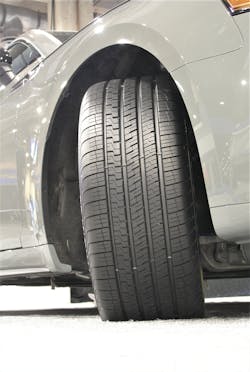Defining Performance: Speed Ratings are No Longer the Emphasis. Still…
It is time to officially re-think the definitions for high and ultra-high performance tires. Speed ratings are not enough anymore. Neither is aspect ratio. Quite frankly, they haven’t been enough for many years. Evolution in tire development continues to make those factors less relevant.
Original equipment fitments, designated use and marketing also have to be taken into consideration. So do size and profile as they relate to performance.
“When the term ‘high performance tire’ is mentioned, it often stimulates visions of high speed, horsepower and racing,” says Bob Toth, director of industry relations for Goodyear Tire & Rubber Co. “But technically, high performance is all about improving vehicle maneuverability.”
Toth helped develop Goodyear’s Eagle line in 1981. “As always, optimizing tire performance involves a complicated puzzle of performance attribute tradeoffs assembled to give consumers the specific performance balance desired,” he says.
A brief history of performance
Ironically, there is no speed rating symbol requirement in the U.S. They were first established in Europe, where they are mandatory.
In the U.S., a tire only has to meet U.S. Department of Transportation Federal Motor Vehicle Safety Standards and their high speed performance test procedures. In order to communicate the tire’s speed capabilities to tire dealers and tire buyers, however, U.S. manufacturers began using the European speed rating symbols in the 1980s.
The forerunner of today’s high and ultra-high performance tires may have been the Pirelli P7 radial tire, which was fitted as original equipment on the 1975 Porsche 930 Turbo. “Car and Driver” considered the tire, with its 50- and 55-series sizes, as the first ultra-low-profile tire. “Road & Track” also gave the P7 props, writing it “broke the race/street tire caste system.”
The high performance market, however, arguably began with the creation and marketing of the Goodyear Eagle VR. Also referred to as the Eagle Gatorback because of its tread design, the P255/50VR16 tire was OE on the 1983 Corvette.
In 1985, there were four performance tire definitions: cosmetic, performance, high performance and ultra-high performance. They were defined as follows:
1. Cosmetic tires had no speed markings, but had the look of performance-enhanced tires, despite construction and tread design features to the contrary. The El Dorado Custom Stock 60- and 70-series bias brand (remember that tire?) was an example of a cosmetic performance tire; a 75-series, white sidewall, all-season radial was not.
2. Performance tires generally encompassed 60-, 65- and 70-series tires with S, T and H speed ratings (a few tires in this category were non-speed rated.) The Dunlop GT Qualifier and BFG Radial T/A were two examples.
3. High performance tires were generally defined as 60- and 65-series, H- and V-rated tires. Examples included the Armstrong Formula Road & Trac H, Continental CV51, Firestone Firehawk GT, Goodyear Eagle GT HR, Michelin MXV and Nitto NT-255.
4. Ultra-high performance tires were the smallest niche in the overall performance segment. If a tire was at least V-rated (at the time designed for vehicles that could travel more than 130 mph) with a 55-series aspect ratio or lower, it fell into this segment. Examples of UHP tires included the Bridgestone RE71 Potenza, General XP 2000V, BFGoodrich Comp T/A, Goodyear Eagle VR, Pirelli 700 and Yokohama A008G.
At least in the 1980s and 1990s, speed ratings became synonymous with high and ultra-high performance tires. As the performance capabilities of vehicles increased, tire technology improved and the maximum Z rating — for speeds over 149 mph — had to be more narrowly defined.
Today, V-rated tires have a maximum speed of 149 mph, while W-rated tires have a maximum speed of 168 mph. There are two Y-rated designations: Y, which indicates a tire has a maximum speed of 186 mph; and (Y), which represents speed in excess of 186 mph.
New categories
Sometimes UHP tires are referred to as summer tires, but the two are not interchangeable. Woody Rogers, product information specialist at The Tire Rack Inc., says any tire without an M&S rating is considered a dedicated summer tire. For example, a long-wearing touring tire without an M&S rating is a summer tire, but may not be a UHP tire.
Rogers says Tire Rack breaks down “performance-oriented” summer tires into four categories: extreme performance, max performance, ultra-high performance and high performance. “We look at its intended purpose, but also other factors. How long does it last? How important is ride quality? How does it scale handling and ultimate traction in wet or dry?”
Speed ratings help with the definition, but as Rogers says, a speed rating is not a performance rating. “It merely indicates how fast it can go in an endurance test, which is in a laboratory.” Does an M&S designation keep a tire from being a high or ultra-high performance tire? No. Tire Rack also has categories for UHP all-season and high performance all-season tires.
High performance attributes
Here’s an example of how a high or ultra-high performance tire sale might have gone down in 1962.
A couple of guys riding around in a Corvette stop at a tire dealership and tell the dealer they need new tires. When asked what kind, the driver says, “Nylon premiums, the best.” The dealer replies, “That’ll run you $45 apiece.” Unconcerned, the driver agrees to the sales price.
More than 50 years later, the definition of “performance tire” continues to evolve.
“More than ever before, new cars today, even mainstream four-door sedans, come in trim levels requiring tires leaning more toward the high performance end of the performance attribute continuum and emphasizing handling capabilities that surpass ‘high performance’ vehicles from the past,” says Toth.
“Generally, high performance tires continue to get better, standard passenger car tires continue to get better — with more performance-oriented attributes — and the capabilities of entry-level performance/touring tires from yesterday have slowly evolved to become today’s standard passenger car tires.
“High performance tires are still those tires that are specifically designed to emphasize high performance attributes like steering precision, cornering power, dry traction and responsive handling, often at the expense of things like long wear, cold weather traction, soft ride and/or low noise.” ?




